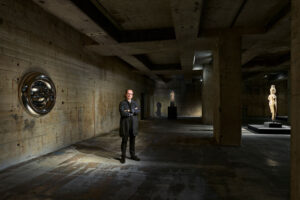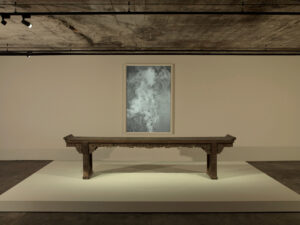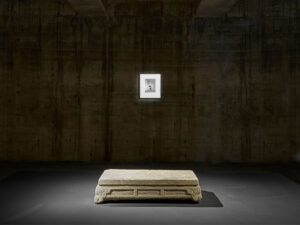The Feuerle Collection is a non-profit organization founded by Désiré Feuerle and Sara Puig in 2016. Both founding members have an artistic background, as Feuerle ran a gallery in the 1990s, in Cologne, where he dealt with works of ancient, modern and contemporary art, while Puig is the founder of the Sara Puig Institute for the Arts and holds the position of president of the Fundació Joan Miró in Barcelona. The collection houses works from the Han dynasty to the first Qing dynasty, juxtaposed with early Khmer sculptures from the 7th to 13th centuries and contemporary works by Zeng Fanzhi, Nobuyoshi Araki, Anish Kapoor, James Lee Byars, Cristina Iglesias and Adam Fuss. Twilight and darkness are the guidelines of the entire installation so that the distinction between the cone of light centered on the art object and the surrounding environment that welcomes it creates a sort of ambiguous and rarefied atmosphere that favors recollection, meditation and purification. In this way the visit becomes a kind of ritual, a journey into the bowels of the earth to then go up again along the marginal sides of one’s conscience. Absurdly, everything recalls a sacred rite, a ceremony where the visitor becomes the faithful who approaches the simulacrum, the image of the divinity. All with a lot of balance and with the deployment of works of the highest quality.
The collection found a home in a former World War II telecommunications bunker (the so-called Basa-Bunker on Halleschen Ufer in Kreuzberg) which was renovated by British architect John Pawson, with a mix of brutalist and minimalist touches.
The idea behind the Feuerle Collection is that of a three hundred and sixty-degree work of art, without distinction of places of origin and time, so that dissimilar and distant signs can form an organic and integrated body, a kind of vibrating and meaningful signal. According to this modality of arrangement and juxtaposition of the works, the traditional chronological scheme falls in favor of empathic relationships or visual assonance. This is a rule, now applied in many museums and in numerous contemporary art exhibitions. It must be confessed that this method makes it more difficult to read and contextualize the work, but it certainly gives a greater charm to the visit path, making it special and engaging.
According to this idea, the contemporary work of art becomes timeless, the ancient becomes contemporary, the different works of art blend together to create a new imaginative sensation. Which, translated in another way, means: “All art is contemporary” or, quoting Salvatore Settis, “between ancient and contemporary there is no clear fracture but a perpetual tension, a continuous postponement of forms and styles. However, we can go back to Alois Riegl: “What it once was can never go back to being, and everything that has been represents the irreplaceable and indissoluble link in a chain of development”. I also remember the “counterpoints” that Peggy Guggenheim, in her house in Venice, had built between the works of her beloved artists from the twentieth century (Braque, Calder, Picasso …) and the aboriginal masks: a close dialogue between signs and meanings dissimilar and at the same time a path of chronological rupture.
To put it in the words of Désiré Feuerle “different cultures create similar feelings or contradict the classical perspective, looking at a work of art as if it were juxtaposed with something you would not expect or with something that is even breaking harmony and, through this, creates a new perspective on the artistic experience”.
Finally, I like to close this article with a quote from the Canadian literary critic Northrop Frye: a doctor, traveling in the Arctic tundra, immersed in the icy darkness of a snowstorm, and without any reference point anymore, exclaims desperately: “lost!” The Inuit guide, who accompanied him, looking intently at him replied: “We are not lost, we are here”. Here, the Feuerle Collection, with its 7 thousand square meters of exhibition space, is a kind of “here” or an affirmation on the awareness of perceiving about what usually cannot be seen.
Roberto Grisancich
Info:
The Feuerle Collection
Hallesches Ufer 70
10963 Berlino
info@thefeuerlecollection.org
visite su appuntamento
 The Feuerle Collection building. Photo def image. Courtesy The Feuerle Collection, Berlin
The Feuerle Collection building. Photo def image. Courtesy The Feuerle Collection, Berlin
 Désiré Feuerle inside The Feuerle Collection. Anish Kapoor, Torus, 2002 (steel) and Khmer sculptures, in the background: Adorned Buddha Protected by Naga, Bayon Style, 13th century, polychrome wood. On the right: Vishnu, Banteai Srei Style, 10th century. Photo def image © The Feuerle Collection, Berlin
Désiré Feuerle inside The Feuerle Collection. Anish Kapoor, Torus, 2002 (steel) and Khmer sculptures, in the background: Adorned Buddha Protected by Naga, Bayon Style, 13th century, polychrome wood. On the right: Vishnu, Banteai Srei Style, 10th century. Photo def image © The Feuerle Collection, Berlin
 Installation view of The Feuerle Collection. Adam Fuss, From the series My Ghost (unique gelatin silver print photogram) with Large Side Table with Everted Ends, Early Qing Dynasty,17th century, tieli wood. Photo Nic Tenwiggenhorn © Nic Tenwiggenhorn / VG Bild-Kunst, Bonn, courtesy The Feuerle Collection, Berlin
Installation view of The Feuerle Collection. Adam Fuss, From the series My Ghost (unique gelatin silver print photogram) with Large Side Table with Everted Ends, Early Qing Dynasty,17th century, tieli wood. Photo Nic Tenwiggenhorn © Nic Tenwiggenhorn / VG Bild-Kunst, Bonn, courtesy The Feuerle Collection, Berlin
 Istallation view of The Feuerle Collection. Nobuyoshi Araki, Tokyo Comedy, 1997/2015 (gelatin silver print) with Stone Table, Song Dynasty to early Ming Dynasty, China, 10thcentury-15th century, limestone. Photo def image © The Feuerle Collection, Berlin
Istallation view of The Feuerle Collection. Nobuyoshi Araki, Tokyo Comedy, 1997/2015 (gelatin silver print) with Stone Table, Song Dynasty to early Ming Dynasty, China, 10thcentury-15th century, limestone. Photo def image © The Feuerle Collection, Berlin

is a contemporary art magazine since 1980






NO COMMENT